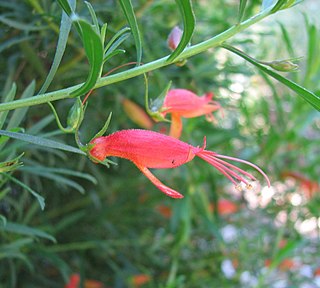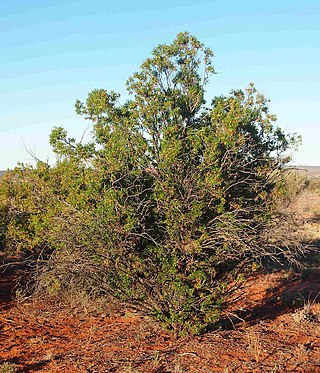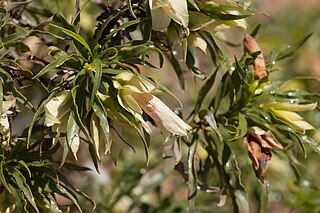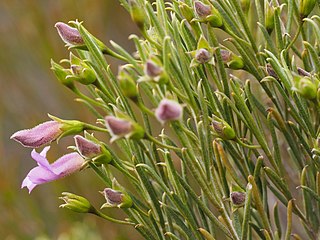
Eremophila freelingii, commonly known as limestone fuchsia or rock fuchsia bush, is a flowering plant in the figwort family, Scrophulariaceae and is endemic to Australia. It is a shrub with sticky, hairy, lance-shaped leaves and flowers a shade of light to dark lilac and which occurs in Queensland, New South Wales and South Australia.

Eremophila decipiens, commonly known as slender fuchsia bush or narrow-leaved fuchsia bush is a flowering plant in the figwort family, Scrophulariaceae and is endemic to an area extending from the south-west of Western Australia to southern parts of South Australia. It is low, sprawling shrub with lance-shaped leaves and red, orange or yellow flowers on a long, S-shaped stalk.

Eremophila duttonii, commonly known as budda or harlequin fuchsia bush, is a flowering plant in the figwort family, Scrophulariaceae and is endemic to mainland Australia where it occurs in all the mainland states except Victoria. It is a shrub or small tree with dark green, sticky leaves and flowers that are red on top fading to yellow-green below. Extracts from this plant have been shown to have significant antimicrobial activity.

Eremophila alatisepala is a plant in the figwort family, Scrophulariaceae and is endemic to the south-west of Queensland in Australia. It is a very sticky shrub covered with many glandular hairs which produce a resin that often obscures the hairs that produce it. The plant is usually found in stony places on ridges and slopes in the Queensland Channel Country.
Eremophila conglomerata is a flowering plant in the figwort family, Scrophulariaceae and is endemic to central areas of Western Australia. It is an erect shrub with small, serrated leaves and mauve to blue flowers that extend well beyond the foliage.
Eremophila dendritica is a flowering plant in the figwort family, Scrophulariaceae and is endemic to the south of Australia. It is a low, shrub with many tangled branches. Its branches, leaves and flowers are densely covered with hairs giving them a felty texture.
Eremophila falcata is a flowering plant in the figwort family, Scrophulariaceae and is endemic to Western Australia. It is a widely distributed shrub with distinctive curved leaves and white, lilac-coloured or pink flowers.

Eremophila flabellata is a flowering plant in the figwort family, Scrophulariaceae and is endemic to Western Australia. It is a small shrub with serrated leaves, broad serrated sepals and pink, purple or mauve flowers.

Eremophila flaccida is a flowering plant in the figwort family, Scrophulariaceae and is endemic to Western Australia. It is a low, spreading shrub with sticky, shiny foliage and large, attractive flowers. There are two subspecies, one common and relatively widespread, the other known from only a few locations.

Eremophila foliosissima, commonly known as poverty bush, is a flowering plant in the figwort family, Scrophulariaceae and is endemic to Western Australia. It is a small, erect, densely foliaged shrub with long, narrow, hairy leaves and mauve to purple flowers. It is similar to Eremophila gilesii but is more dense and rounded, has more crowded leaves and has different hairs on the flowers.

Eremophila glandulifera is a flowering plant in the figwort family, Scrophulariaceae and is endemic to Western Australia. It is a small shrub with hairy, grey foliage and attractive deep pink to red flowers usually growing in mulga woodland.

Eremophila glutinosa, commonly known as sticky emu bush, is a flowering plant in the figwort family, Scrophulariaceae and is endemic to Western Australia. It is an erect, densely foliaged shrub with branches and leaves sticky and shiny due to the presence of resin. It has hairy sepals and lilac-coloured flowers.

Eremophila labrosa is a flowering plant in the figwort family, Scrophulariaceae and is endemic to Western Australia. It is a shrub with many hairy branches arising from near ground level, narrow, hooked leaves and mauve and blue flowers.

Eremophila lanceolata is a flowering plant in the figwort family, Scrophulariaceae and is endemic to Western Australia. It is a low, spreading shrub with foliage which is shiny when young, angular branches and lilac to purple flowers and which grows in the north-west of Western Australia.

Eremophila linearis, commonly known as harlequin fuchsia bush, is a flowering plant in the figwort family, Scrophulariaceae and is endemic to Western Australia. It is a shrub with long leaves, sticky, shiny leaves and branches and bright red flowers
Eremophila micrantha, commonly known as small-flowered poverty bush, is a flowering plant in the figwort family, Scrophulariaceae and is endemic to Western Australia. It is a rounded shrub with many thin, flexible branches, narrow leaves and small white flowers.
Eremophila prostrata, commonly known as Rainbow Valley fuchsia bush, is a flowering plant in the figwort family, Scrophulariaceae and is endemic to the Northern Territory. It is a prostrate shrub with glabrous branches and leaves and purple flowers. It occurs as a few scattered populations with a total area of less than 50 ha.

Eremophila serrulata, commonly known as serrate-leaved eremophila, is a flowering plant in the figwort family, Scrophulariaceae and is endemic to Australia. It is an erect or spreading shrub whose leaves are sticky and have small serrations, and flowers that have green, yellowish-green or yellowish-brown petals.

Eremophila spuria is a flowering plant in the figwort family, Scrophulariaceae and is endemic to Western Australia. It is an erect, open shrub with narrow leaves and blue, lilac, purple or white flowers and is a common and widespread species.
Eremophila succinea is a flowering plant in the figwort family, Scrophulariaceae and is endemic to Western Australia. It is an erect, broom-shaped shrub with sticky, narrow, hooked leaves, narrow, sticky sepals and hairy, pale purple or mauve petals.















